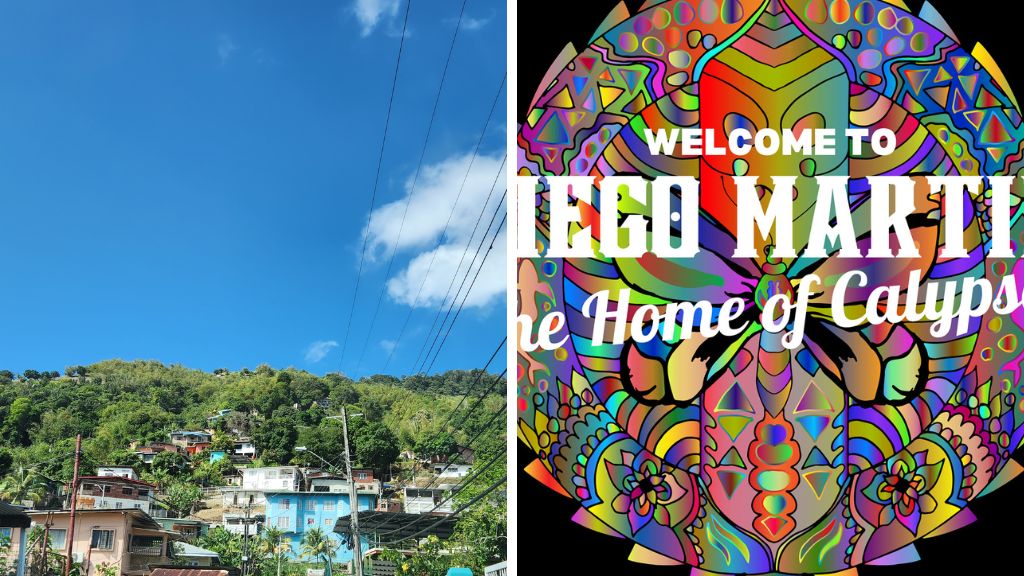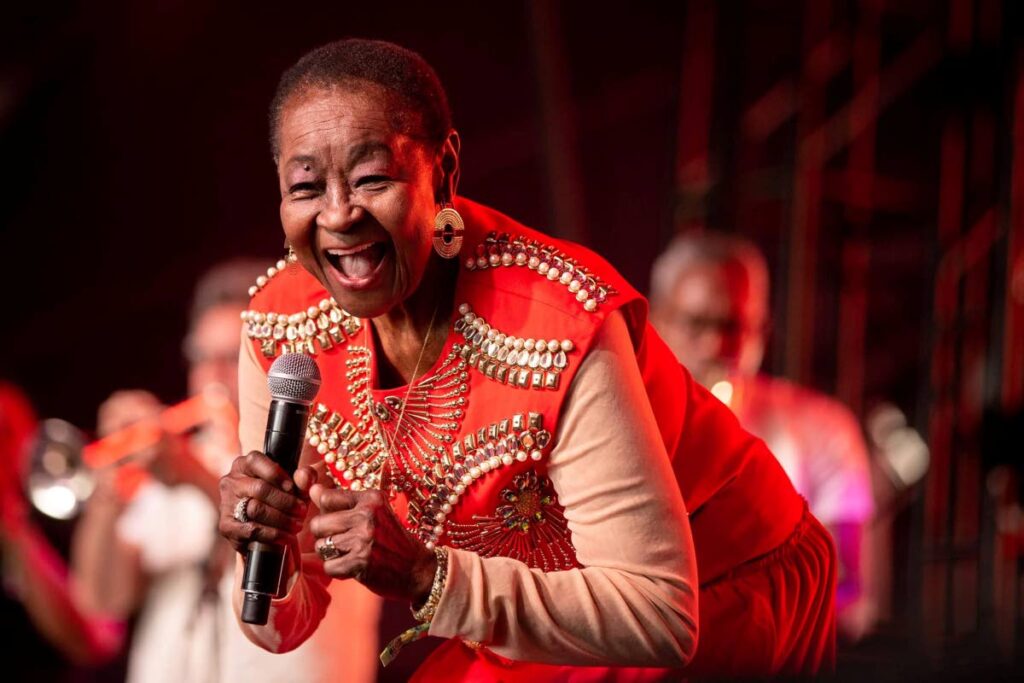 It’s well-known that visitors from around the world visit our shores to get a taste of our local cuisine—from food critic Anthony Bourdain to travel vlogger Nicholas Nuvan, foreigners have become admirers of our native dishes.
But what of Trinis travelling and living overseas, taking our culinary traditions to introduce them to the people in those countries? This isn’t unusual in the United States and Canada, where a large contingent of the Caribbean diaspora resides, but in non-anglophone spaces, it’s fairly less common. This is what Carla and Justin Audroing had in mind when they launched Trini Bites in their home of the past five years, Paris, France. Carla Audroing spoke with Loop News about moving to France with her husband and two young daughters, her passion for Trinbagonian cuisine and her drive to share it with others. Settling in and starting small Born and bred Trinbagionians, the couple decided to take advantage of Justin’s French citizenship to broaden their options for where they could raise their two young daughters and expand their respective careers. “When we had our kids, we wanted to settle down somewhere,” she shared. “It was a decision I questioned a lot in the first few years [but] we’re now settling down properly into the life and culture.” Audroing spoke of the rough start when the young family first moved to Paris back in 2019, getting adjusted, along with some less-than-pleasant interactions before eventually finding her tribe. A maritime consultant by profession, Audroing enjoys cooking for her family and for others and began sharing her food with her colleagues at work. “I used to cook for my coworkers,” she shared. “During the pandemic, when everyone was making doubles, we started to do it too. I took for my coworkers to try Trinidad food [and] everyone really, really liked it.” She mentioned that her Indian colleagues were particularly fond of the doubles, saying that it reminded them of food from back home. The positive reviews from her colleagues, a relatively international bunch, encouraged the couple to start thinking about expanding their reach and developing their Trini cooking into a concrete business idea. In December 2021, they rented their apartment building’s recreational area to host a tasting for the other residents, this time, adding sweet treats such as coconut fudge and black cake to the menu. The couple used the event as market research to gauge responses from the public and to get an understanding of what flavours they may have to adjust to adapt to the French palate without watering down the authenticity of the dishes. Soon after, they launched into doing Trini-style lunches for their neighbours. While the responses were mostly positive, Audroing mentioned that many of the older residents weren’t too fond of the fact that they had to eat the doubles with their hands whereas the younger crowd were more open to the idea of non-Western concepts of street food meant to be eaten in this way. Taking this into account, they began offering cutlery. Red beans and rice, stewed chicken, stewed pork and curry dishes were among some of the meals on the Audroings’ menu, which quickly became a hit with their customers. Justin being a gourmet chef, this venture gave him the opportunity to put his culinary training to use, experimenting with local flavours and using the ingredients found in Europe to mirror that of the local products for maximum authenticity. Venturing into the event space Ever eager to make Caribbean connections in her new environment, Audroing came across an ad for Paris steelband group Calypsociation’s 30th anniversary event in July of last year and saw it as an opportunity to offer their services. “We contacted them and told them we do Trini food and said ‘Could we come and do doubles?’” The response was an instant yes, as the organisers thought the pair would help to give the event more of an authentic feel. “It was very, very successful,” Audroing said. “People were lining up—long, long lines.” The event offered an excellent networking opportunity, allowing the pair to begin making their way into Trinbagonian and other Caribbean spaces with requests to appear at other events. “Word began to spread among the French pan community,” she said, and she soon became known as “the doubles woman” among the community of Trinbagonians living in Paris. By May, the couple found themselves taking the business outside of Paris for the first time, to Nantes, for Panfest, an all-day steelpan festival organised by the city’s resident band, Calyps’Atlantic—coached by our very own Duvone Stewart—which saw some six bands from various French cities come together for a full day of steelpan music and good vibes. The event itself was a first, the massive undertaking of uniting several bands in one venue. As with the Paris event the previous year, the Audroing’s doubles would be the perfect culinary touch. Once again, Trini Bites was well received; the couple crossed paths with a handful of other Trinbagonians while in Nantes, including one homesick Trinbagonian who travelled from a nearby town to get her fix of local culture. Keeping the culture alive overseas Audroing spoke of the sense of pride she is able to draw from preparing these meals on a larger scale and sees expansion as a way forward, aiming to launch the first Trinibagonian food spot in France. “I’m amazed that there isn’t one already; French people love to try new food and different restaurants,” she said. “I want people to experience Trini culture—I think we’re so underrepresented here.” For Audroing, preparing her native cuisine in a foreign place is not only a side hustle, but a means of staying rooted to her culture, not only for herself, but for her daughters, who, apart from visits back home here and there, won’t have an attachment to Trinidad and Tobago as strong as the ones their parents do. “I see the food business as more than a means to money,” she explained. [My daughters] eat the food [but] they don’t connect to Trinidad in the way that I do and Justin does. Food is one of the ways that they make that connection. For us, this is keeping our culture alive.” Check out Trini Bites on Facebook for more information. (Source: The Loopm October 20m 2024) 900-foot mural depicting the entire history of Calypso will be started, this Calypso History Month, in Cemetery Street in Covigne, Diego Martin, as part of the historic ‘Diego Martin- Home of Calypso Project’ that was launched in 2023.
In a statement, the Artists’ Coalition of Trinidad and Tobago (ACTT) said the Upper Cemetery Street Residents Association (USCRA), the estates of a number of Calypso legends, and other Diego Martin stakeholders are collaborating with the ACTT in this groundbreaking project. The group said the project comes out of historical research showing Diego Martin’s bonafides as the "birthplace of Calypso", along with a series of startling intersections the new Borough has with Calypso history. The group said the first gesture in this declaration will be the commencement of the 900-foot mural which is to be completed by March 2025, in time for Carnival 2025. “The Mural will just be the first of many different initiatives that will be unveiled in the coming months and years to transform Diego Martin into an international Calypso Heritage destination. “The intention is for the first stage of painting (200-feet) to begin during Calypso History Month in October to get student participation. “However, for the next phase, about 400 feet of wall must be prepared by being plastered and reinforced alongside certain road-works that would need to be done by the Diego Martin Regional Corporation. “This work should be started and completed by year end so that the entire 900-foot wall could be completed in time for Carnival 2025.” The group said the mural will be a national and international tourist destination and will depict the entire history of the Calypso tradition from its roots in the Diego Martin slave plantations of the 1700s through its rise and explosion into a World Music in the 1900s. “The mural will depict hundreds of Trinidad and Tobago’s greatest musical talents like Sparrow, Kitchener, Rudder, Rose, Super Blue, Shadow, Stalin, Machel, Spoiler, Attilah, Tiger, and more in a stunning timeline pageant of portraits in colour." The group said the mural will be painted by some of Trinidad and Tobago’s greatest painters and muralists, whilst including school children, youth groups, elders, and more. The group said the entire community will be encouraged to ‘put a hand’ in the process. The group said the mural will transform the community of Covigne, particularly Cemetery Street, which has become desolate because of the dilapidated look of the unpainted wall which runs along almost its entire length. The group said all members of the neighbourhood have already given their permissions for the historic mural to happen on their walls. Meetings with the United Nations have also been had to discuss the larger Heritage implications of the project. The project has been endorsed by past Monarch David Rudder, as well as the estates of both the Mighty Sparrow and the Lord Kitchener. ACTT president Rubadiri Victor said: “The aim of the HOME OF CALYPSO Project is to attract up to 100,000 unique domestic and overseas visitors to Diego Martin annually- as well as other forms of tourism. This project could change the fate and face of Diego for the better and release multi-million-dollar entrepreneurial multipliers in the community. “It would also assist in the rehabilitation of the collapsing hillside communities and delinquent boys- from Patna, Bagatelle, and Covigne, amongst others. Ultimately the ‘Home of Calypso’ project could contribute toward generating and circulating millions of dollars in foreign exchange within Diego Martin, surrounding communities, and Trinidad & Tobago as a whole.” The group said Diego Martin was chosen as ‘The Home of Calypso’ following research conducted by Victor during a Commonwealth Foundation grant project. The research revealed the following fascinating cluster of facts: The first 6 Calypsonians mentioned in the historical record came from slave plantations in Diego Martin. One plantation in particular, the Begorrat plantation in Covigne, was seminally important to the establishment of the form. The group said the first three Calypsonians ever, Gros Jean (1790-1820), So So, and Papa Cochon (who also happened to be a legendary obeahman), came from Diego Martin. “The tomb of Gros Jean is located at the corner of Covigne Road and Richardson Street in Diego Martin at what was once the Bergorrat family cemetery. “Calypso was 'born' in the Covigne caves beneath Begorrat's great house. That Calypso was born in a cave is an incredible Creation Myth! The network of caves is said to extend all the way to West coast beaches like Macqueripe where Begorrat was rumoured to have run contraband and illegal slaves.” Victor said many of Calypso’s greatest Kings have taken up residence in the Diego Martin valley, including the Mighty Sparrow, the Lord Kitchener, Chalkdust, and David Rudder. “The first ever crowned Calypso King (1939), “The Growling Tiger” was born in Diego Martin. “Many other Calypso legends have also called Diego Martin home: Brigo, Funny, Lord Superior, Denyse Plummer, Marcia Miranda, the duo Regeneration Now, and brass bandleader Roy Cape. “One of the greatest writers of Calypso, the late Winsford Devine, also called Diego Martin home, alongside contemporary voices like Kerwyn Du Bois and Maximus Dan who were born there." The largest archive of Trinidad and Tobago music and Calypso also exists in Diego - the Shawn Randoo collection. Randoo is also a first-class historian of the genre. Victor said this is important as the two largest collections of Trinidadian and Calypso music both reside outside of Trinidad and Tobago. The first is located in Alaska with US historian and ex-judge Ray Funk. The second is located in Canada, recently sold by Trini-born Toronto native George Maharaj. Victor said: “That all of these important proponents of the Calypso artform have come to reside in Diego Martin, in the shadow of the Hills where Calypso was born, is amazing spiritual choreography.” “Calypso is one of the ten root musical forms in the Western world, in a list that includes Blues, Rock, R&B, Reggae, Jazz, and more. “The first Calypso recording was done in 1912- ‘Mango Vert’ by Loveys Band, making Calypso one of the oldest recorded pieces of music in the world, pre-dating Jazz by five years. “Calypso is also the mother-form for the music of the Caribbean basin as far north as New Orleans all the way down to the South American mainland. Reggae evolved from Calypso. “Calypso also precipitated the rise of West African music like Hi-Life and was instrumental in the re-routing of West African music back to their ancestral roots. “Calypso has profoundly influenced the trajectory of many forms of popular music from Disco, Afrobeat, Dancehall, and Reggaeton, to Afro Beats and EDM, etc. At the heart of all this is the power and always evolving majesty of the thing called Calypso.” To contribute or keep updated on the project, follow “Diego Martin Home of Calypso on Facebook: https://www.facebook.com/profile.php?id=100090180610072 Anyone interested in the project can call or message 1-868-797-0949. (source: the Loop, October 20, 2024) In the first chapter of this three-part series written by historian Angelo Bissessarsingh we are given an insight into the religious awakenings of Hinduism under indentureship among the Indo-Trinidadians of the 19th century.
CHAPTER 1 Hinduism Arrival in the West Indies. Author : Angelo Bissessarsingh. As a historian and erstwhile anthropologist it never ceases to amaze me at how religious and cultural tolerance manifests itself in Trinidad and Tobago. Almost every schoolchild can recite a basic understanding of the annual Hindu festival of Lights, Divali. They know the elements of the triumph of light over darkness, good over evil, bits of the sacred Ramayana and the welcoming of the goddess Lakshmi into the home to ensure a year of prosperity for the family. There are few communities here where in the Hindu calendar month of Kartik (although the earlier month of Ashvin sometimes encompasses the festival) where the firefly lights of tiny clay deyas do not shine forth on the night of the festival, upholding ancient traditions deeply rooted in our ancestry. To fully understand the portent of Divali (Deepaavali as the celebration is known in India) one must take a brief look at the roots of Hinduism in Trinidad and Tobago. In 1845 a group of indentured immigrants arrived from India aboard the Fatel Razack as the first of thousands who would flock hither to found a new society in an alien land. With them to the west came the ancient ways of their motherland and Hinduism had arrived. Initially there was no provision for any cultural or religious freedom since the colonial authorities merely envisioned the presence of the Indians as an easily-replenished source of labour bound to fixed contracts. It was only when the eminent suitability of these people for sugar estate work became apparent then financial and land incentives were offered between 1860 and 1880 which resulted in the formation of a permanent peasant class. It is with this firm establishment that itinerant babajis or pundits began to appear in the villages of their people alongside quaint mandirs with mud walls and carat-thatched roofs. A few of these holy men were real Brahmins but these were in the minority with a large number merely being elevated to piety by having a considerable knowledge of the epics of the Ramayana and Mahabharata. Although most of the indentured immigrants were from agrarian classes were from rural stock and formerly bound by the fetters of the caste system, it was noted in 1887 by J.H Collens (in a rather myopic account) that a widespread knowledge of the epics was apparent and this of course was the local origin of the Ramayana readings and Ramleela plays which have characterized Indo -Trinidadian Hinduism ever since: “It must be acknowledged that the Puranas are a mass of contradiction, extravagance, and idolatry, though couched in highly poetical language. It is, nevertheless, astonishing how familiar the Trinidadian coolies are with them ; even amongst the humble labourers who till our fields there is a considerable knowledge of them, and you may often in the evening, work being done, see and hear a group of coolies crouching down in a semicircle, chanting whole stanzas of the epic poems, Ramayan etc. In the preface of the Ramayan it is stated that he who constantly hears and sings this poem will obtain the highest bliss hereafter, and become as one of the gods.” It is this spiritual awakening which inevitably led to the introduction of Divali and other Hindu festivals to Trinidad. In the next chapter of this series, we will look at how deyas punctuated the darkness in rural Trinidad as Divali emerged as a national phenomenon. Photo :Three babas or pundits in Trinidad circa 1894. The permanent settlement of formerly indentured immigrants paved the way for a cultural and religious expansion of their identities hitherto suppressed by the colonial plantocracy. (Source: Virtual Museum of T&T, Oct 25, 2024) TWO iconic calypsonians will be honoured by the Tobago House of Assembly (THA) on October 25, to herald the official start of the third instalment of the Tobago carnival.
McCartha Linda Sandy-Lewis, also known as Calypso Rose, and the late Winston Bailey, stage name The Mighty Shadow, are two of eight icons, five posthumously, set to be honoured for their contribution to nation-building, culture and leadership. At a post-executive council news briefing on October 23, Assistant Secretary of Tourism, Culture, Antiquities and Transportation Niall George said the THA will celebrate the icons by renaming prominent streets and landmarks. The other six icons are legendary football coach Bertille St Clair; former chief administrator Allan Richards; the late politician and pharmacist James AA Biggart; deceased anthropologist Dr Jacob Delworth Elder; Aloysius Morean and Edna Morean (education), both deceased. Secretary of Infrastructure Trevor James said it is important to pay homage to those that have inspired Tobagonians over the years. In a media release on October 23, he said, “Tobago does not only have a proud heritage but also a collection of legends that have made their marks on the international stage and psyche of what it means to be Tobagonian. We are a great people deserving of honour, and as an Executive and citizenry, we owe it to them to recollect, recognise and celebrate, as a joint expression of gratitude, and for younger ones to see and be inspired as well.” The event is set to take place at the Scarborough Esplanade. As the carnival festivities began on October 23 with the Soca Titans competition, George predicted a bumper carnival season, set to culminate on October 27 with the parade of the bands. He said he has received reports from hoteliers that occupancy is at 100 per cent. “We’re also receiving reports of an increase in costume sales. I know there would be late persons trying to get on to the island, in that sphere, we are hoping that we receive the support that we asked for from both Caribbean Airlines and the Port Authority.” He said the theme of this year's event is mud and revelry, as he called on those who intend to patronise the events to make it unprecedented, whilst also making prioritising safety. “We would have done our last safety checks on last week Friday which would have been a tabletop exercise. We would have been presented with many scenarios and how they would be solved.” He added: “We are saying to Tobago, have fun, have clean fun and know that the background work would have been done so as to ensure that we have a very safe and successful carnival. I am saying to each and every one, let us enjoy the festivities to the best of our ability, let us come out, let us make the best of it.” He encouraged the patrons to make use of the spots after the festivities to take photos. “Enjoy the beauty of the island, enjoy the cuisine of the island, the warmth of the people on the island and let’s make it the best as we take this step in continuing to make Tobago the greatest little island on the planet.” (Source: Newsday, October 23, 2024) MEMBERS of the Surinamese First Peoples participate in the Water Ritual, part of Heritage Week activities hosted by the Santa Rosa First Peoples Community at the Arima River, Blanchisseuse Road on October 12.
The Santa Rosa First Peoples community held its annual Water Ritual at the river, celebrating their cultural heritage and spiritual connections. The ritual brought together members from various tribes, including the Trio Tribe from Suriname, who adorned themselves in traditional costumes and sacred body paint. According to Ricardo Bharath Hernandez, Santa Rosa First Peoples’ chief, the tribal garments are crucial for honouring the spirits and ancestors, allowing participants to seek direct messages through their connection with nature. The ceremony featured offerings made to the water, emphasising the community's deep respect for the environment and its role in their spiritual practices. Elders and leaders of the various tribes, including Bharath Hernandez, played pivotal roles in guiding the rituals, ensuring sacred traditions were upheld, and fostering a sense of unity and reverence among participants. The event not only highlighted the community's rich cultural heritage but also reinforced their ongoing with the spiritual world. The Water Ritual is part of the Santa Rosa First Peoples Community Heritage Week celebrations from October 12-18. Other events include a film screening at the Arima mayor’s temporary office on October 15, a ceremony remembering the ancestors at the Red House in Port of Spain on October 16, and a cultural and social mixer at the Heritage Village, Arima, on October 18. (Source: Newsday, October 15, 2024) |
T&T news blogThe intent of this blog is to bring some news from home and other fun items. If you enjoy what you read, please leave us a comment.. Archives
May 2025
Categories
All
|









 RSS Feed
RSS Feed